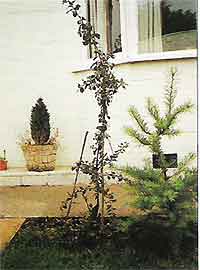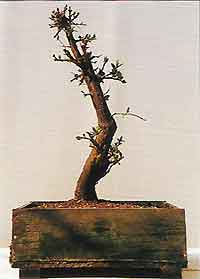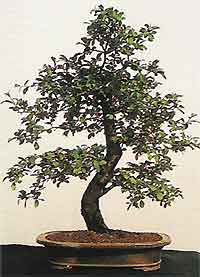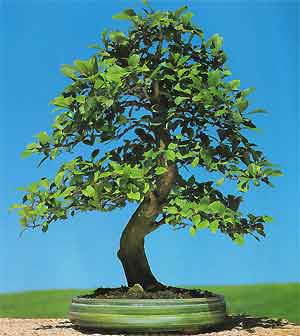Bonsai Trees
Case Histories
Sloe - (prunus spinosa)
Sloe Bonsai Style: Informal Upright

One winter's morning I had the fortune to notice a local farmer removing a small section of his hedge and replacing it with a gate. Knowing what gems a hedge can hide, I stopped and spotted a sloe with an interesting trunk, lying amongst the pile of trees that he intended burning.
The farmer seemed quite bemused when I asked if I could have it and said that I was welcome to take whatever I wanted. I quickly discarded the rest of the trees, which displayed little potential and happily returned home with my sloe. This was a species that I had always wanted in my collection, particularly as it is a native tree.

The roots were badly damaged as the tree had clearly been hurriedly ripped from the ground. I pruned them back neatly and painted the cuts with wound sealant to prevent disease. At this stage the trunk was also heavily pruned to 25 cm (10 inches) as the growth above this point was uninteresting and lacked appeal. A small side branch became the new leader and the tree was planted in the front garden to recover.
That year it grew strongly and by lightly pruning all side growth, I forced the sloe to put all its energy into the new leader so that it would thicken and the 'chop' would become less obvious. It soon reached almost 2 metres (over 6 feet) in height and the tree seemed to be growing well. The next year, to create good taper I pruned the new growth down to 15 cm (6 inches) and trained another side branch up as the leader, which was allowed to grow unchecked for the rest of the season.
Sloe Bonsai History: Training

After the sloe had been in the garden for two years I reduced the height once more and pruned the branches back to begin its training in a box. Normally when trees grow, every shoot that extends corresponds to a root growing. I was completely amazed when I discovered that the tree's roots were virtually unchanged from when it had been planted in the garden so long ago. How had it been possible that this tree had made so much growth on such poor roots? I immediately potted into a square box, using a very open mix of mainly grit and akadama, hoping that this soil would promote fibrous roots.
The tree budded well and I let the shoots develop, wiring several in place to establish a definite branch structure. I fed heavily, but did not prune the growth as I was conscious that the roots were poor and needed to recover. The next spring the tree had become so pot bound with fibrous roots that it was difficult to remove from the box. I was both relieved and overjoyed to find that the soil mixture had enabled this to happen. A large bonsai pot was selected, the sloe was root pruned, wired and the trunk angle was slightly changed.

I wondered whether it would flower that spring, but was not surprised when none appeared. Now that the tree was strong, with a healthy root system, I pruned off many unnecessary branches and wired the remaining shoots into a tree-like structure. In the autumn I fed with bonemeal in an attempt to promote flowers.
The following spring my patience was rewarded with an excellent display of small white flowers, evenly distributed amongst the branches. It looked an absolute picture and also flowered the following year, although not so heavily. This was quite normal as many flowering trees tend to flower well every other year, flowering only sparsely for the year in between.
Two years later and the tree was rather overgrown having not received much attention. It now needed some serious styling. I prefer to work on deciduous trees in the winter as trees are so much easier to wire without leaves and also the structure can be fully appreciated. Many branches were pruned off as I was confident that the remaining ones I intended to use were alive. Every single branch and twig was wired into shape and the sloe was given winter protection because of the pruning. I was aware that I had probably removed many of that year's flowers, but the shape was more important to me - there will be many more spectacular springs to look forward to!
 One winter's morning I had the fortune to notice a local farmer removing a small section of his hedge and replacing it with a gate. Knowing what gems a hedge can hide, I stopped and spotted a sloe with an interesting trunk, lying amongst the pile of trees that he intended burning.
One winter's morning I had the fortune to notice a local farmer removing a small section of his hedge and replacing it with a gate. Knowing what gems a hedge can hide, I stopped and spotted a sloe with an interesting trunk, lying amongst the pile of trees that he intended burning. The roots were badly damaged as the tree had clearly been hurriedly ripped from the ground. I pruned them back neatly and painted the cuts with wound sealant to prevent disease. At this stage the trunk was also heavily pruned to 25 cm (10 inches) as the growth above this point was uninteresting and lacked appeal. A small side branch became the new leader and the tree was planted in the front garden to recover.
The roots were badly damaged as the tree had clearly been hurriedly ripped from the ground. I pruned them back neatly and painted the cuts with wound sealant to prevent disease. At this stage the trunk was also heavily pruned to 25 cm (10 inches) as the growth above this point was uninteresting and lacked appeal. A small side branch became the new leader and the tree was planted in the front garden to recover. After the sloe had been in the garden for two years I reduced the height once more and pruned the branches back to begin its training in a box. Normally when trees grow, every shoot that extends corresponds to a root growing. I was completely amazed when I discovered that the tree's roots were virtually unchanged from when it had been planted in the garden so long ago. How had it been possible that this tree had made so much growth on such poor roots? I immediately potted into a square box, using a very open mix of mainly grit and akadama, hoping that this soil would promote fibrous roots.
After the sloe had been in the garden for two years I reduced the height once more and pruned the branches back to begin its training in a box. Normally when trees grow, every shoot that extends corresponds to a root growing. I was completely amazed when I discovered that the tree's roots were virtually unchanged from when it had been planted in the garden so long ago. How had it been possible that this tree had made so much growth on such poor roots? I immediately potted into a square box, using a very open mix of mainly grit and akadama, hoping that this soil would promote fibrous roots. I wondered whether it would flower that spring, but was not surprised when none appeared. Now that the tree was strong, with a healthy root system, I pruned off many unnecessary branches and wired the remaining shoots into a tree-like structure. In the autumn I fed with bonemeal in an attempt to promote flowers.
I wondered whether it would flower that spring, but was not surprised when none appeared. Now that the tree was strong, with a healthy root system, I pruned off many unnecessary branches and wired the remaining shoots into a tree-like structure. In the autumn I fed with bonemeal in an attempt to promote flowers.